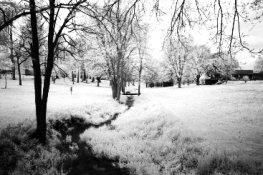I wouldn't be too put off by IR film. To be honest with you it isn't really that different from regular black and white film. One small issue with IR films like Efke 820 film is it is prone to "light piping." Meaning if you take a 35mm roll out of the container even in subdued light it can fog a chunk of the roll because the light travels down the leader into the canister. So just load your camera in a changing bag. The medium format (120) version of the film doesn't have this issue because it doesn't have a leader.
I always keep my film in the freezer both before and after I shoot it. I have no idea if IR film requires that. It's standard practice for me and not an issue.
You can send your film to North Coast Photographic to be developed. As far as I know developing IR film is the same as developing regular film. In fact when I shoot Efke IR 820 I usually make the first exposure with no filter IR or otherwise. I rate the film as ISO 100. The reason I do this is if that frame is developed properly and there is anything screwing with the frames with the IR images I can eliminate processing as the culprit. If you aren't going to buy a truck load of old Kodak IR film or Efke IR film I would advise against developing yourself. The thing with developing yourself is you have to shoot and develop several rolls before you get your system fine tuned. I would not do this with film that has been discontinued. Why dial in a system for a film you will cease shooting in a couple of years. If you want to develop yourself I advise starting off with an emulsion that looks like it might be around for awhile.
Do not worry about what people are calling "true IR" films. All you need is a film that records a decent chunk of the IR spectrum. Anything over 700 nm is infrared. So look at the spectral response of a film and you will be able to tell whether it will record infrared and how much. That's all that matters.
Rollei Retro 80s is often used as a conventional high resolution high contrast film. But from the graph of its spectral sensitivity you can see it is sensitive to IR radiation well beyond 750 nm. People slap a 720 nm meter on their lenses and get pretty good
Wood Effect images.













